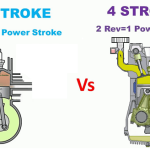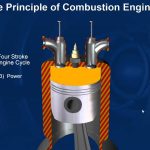1. Meaning of a complete cycle:
a) Intake of Air
b) Compression of Air
c) Injection of Fuel
d) Ignition of Fuel
e) Combustion of fuel & air mixture
f) Expansion of Gases
g) Removal of Exhaust Gases
2. Diesel Engine:
An internal-combustion engine that uses the heat of highly compressed air to ignite a spray of fuel introduced after the start of the compression stroke.
3. Stroke of a Piston:
The distance travelled by the piston from the Top-Dead Center (TDC) to Bottom-Dead Center (BDC) or vice-versa.
4.Clearance Volume:
Volume on top of cylinder when piston is at TDC. Clearance volume spaces forms combustion chamber.
5. Compression ratio:
Obtained by dividing “cylinder volume at BDC” (total volume) by “cylinder volume at TDC” (clearance volume).
*total volume = swept volume + clearance volume
6. Swept Volume:
Volume swept by piston during one stroke.
*swept Volume = piston area x stroke
7. Scavenging:
Low pressure air is used to blow waste gases of combustion out of cylinder. At the same time, fresh air is refilled in the cylinder for use on the next compression stroke.
8. Supercharging:
Increases mass of air supplied to engine per cycle. This will give rise to the pressure of air at the beginning of compression, more than the atmospheric pressure. When supercharging is done by a turbocharger, it is called “turbo-charging”. This allows more fuel to be burnt per cycle for more power.
9. Ignition Quality:
Ability of fuel to ignite by itself under existing condition in the cylinder. Fuel with low ignition quality will take longer time to ignite, thus ignition delay will be longer.
10. Volatility:
The point where liquid changes to vapour. For diesel fuel, volatility is indicated by 90% distillation temperature. The lower this temperature, the higher the volatility of the fuel.
11. Carbon residue:
When oil is burnt in the absence of air, it may leave some carbonaceous residue (carbon content of an oil). Some effects of this:
1) increased wear of piston rings, liner and ring grooves.
2) fouling of exhaust valve and turbocharger turbine.
3) accumulation of carbon at tip of fuel injector.
12. Viscosity:
Measure of oil’s resistance to flow. It indicates the ability of fuel to flow in the fuel oil system and determines lubricating value needed to lubricate fuel pump and injector.
13. Flash point:
Vapours are produced as fuel is heated and at a certain temperature, will “flash” when ignited by an external flame.
14. Pour point:
Indicates the temperature to which fuel must be heated to allow pumping.


